As we as a nation and a world move into the second year of struggling with the COVID-19 pandemic, we find ourselves in a position to look back on the response efforts from the public and private sectors. While many industries were able to mobilize and innovate at a pace previously unseen, the shortcomings of the United States healthcare system resulted in difficulties in response, treatment, diagnosis, and education, among other issues. To look back on the ways we can leverage lessons learned from the COVID-19 pandemic for a future health crisis, the Healthcare Leadership Council (HLC) has released a report detailing the ways private organizations can stay vigilant and prepare for a disaster on a similar scale.
The report notes that these lessons are not simply meant to be used for a future health crisis; as the COVID-19 pandemic continues to claim thousands of lives across the globe with untold economic impact, we collectively find ourselves with a need to adopt and iterate these strategies now. The initiative centers around modernizing data exchange, particularly among and between public health organizations. I’ve written previously about the exchange of healthcare data and how improving digital health systems is the key to leveraging effective insights on population health. The reality of the situation, however, is that despite the growing momentum of modernizing health systems, many organizations are slow to adapt and instead sink countless hours into grappling with systems that have been in place for decades. In many cases, a fear of the upfront costs of making large changes distracts from the very real cost that such outdated systems incur on a regular basis.
And it’s not just hospitals that need a more data-driven approach. Bottlenecks in the healthcare supply chain continue to hamstring distribution efforts for critical supplies during the COVID-19 pandemic, from PPE to the ongoing difficulty in managing the supply of the COVID vaccine. Given the importance of accurate and transparent data in managing disaster response, all parts of the supply chain should develop standards for data reporting, including measures for methods, privacy, and training. This data should be used to monitor stockpiles and prevent supply shocks caused by widespread disruption to a supply chain. These measures would be part of a larger reporting system intended to aggregate data from healthcare organizations to detect burgeoning threats earlier and gauge what a response would look like.
Promoting health equity continues to be a necessity on both a humanitarian and practical level when it comes to addressing a health crisis. Existing public health disparities were exacerbated further by COVID-19, with factors such as cost, accessibility, and education. Furthermore, COVID-19 has disproportionately affected many vulnerable communities, including racial and ethnic minorities, the uninsured, and people living with disabilities. Any response to a public health crisis should be made with adequate representation from these communities and proactively monitor their health outcomes and response measures.
The challenge in combating such a widespread crisis is that it requires revamped efforts from private and public organizations, many of which are still struggling to manage their most pressing issues or update outdated systems. The steps listed above are simply the broadest strokes of the sweeping institutional change that needs to happen to adequately address a massive public health crisis like the COVID-19 pandemic—which still remains uncontained despite mass innovation. Organizations will adapt at different speeds, and many may find their efforts inadequate to combat COVID-19. However, the sooner that these new measures can be put into place, the better positioned we as a nation can be when the next crisis comes.
